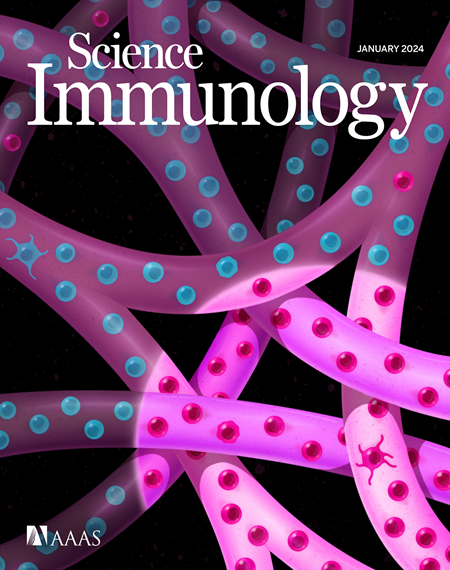Radiotherapy enhances anticancer CD8 T cell responses by cGAMP transfer through LRRC8A/C volume-regulated anion channels
IF 16.3
1区 医学
Q1 IMMUNOLOGY
引用次数: 0
Abstract
The volume-regulated anion channels (VRACs) transport osmolytes, neurotransmitters, and cyclic GMP-AMP (cGAMP) across the cell membrane to regulate cell volume and host defense. We report that the leucine-rich repeat–containing 8A/C (LRRC8A/C) VRAC plays a crucial role in immune responses to radiotherapy and chemotherapy for cancer. VRACs transfer cGAMP from irradiated cancer cells to infiltrating CD4 and CD8 T cells, thus enhancing their effector functions. TCR signaling acts as a physiological signal to open the VRAC pore through phosphatidylinositol 4,5-bisphosphate [PI(4,5)P2] and reactive oxygen species (ROS). This allows the rapid uptake of cGAMP and STING activation in mouse and human T cells and induction of interferon-α/β, which up-regulate granzymes and IFN-γ in CD8 T cells. Inhibition of the extracellular hydroxylases CD39 and ENPP1 maintains extracellular ATP and cGAMP, which promotes VRAC-enhanced CD8 T cell anticancer function. Thus, the transfer of cGAMP to T cells by VRACs may be a strategy that can be targeted in future cancer therapies.

放疗通过LRRC8A/C容量调节阴离子通道通过cGAMP转移增强抗癌CD8 T细胞反应
体积调节阴离子通道(vrac)通过细胞膜运输渗透物、神经递质和环GMP-AMP (cGAMP),调节细胞体积和宿主防御。我们报道了富含亮氨酸的重复序列8A/C (LRRC8A/C) VRAC在癌症放疗和化疗的免疫应答中起着至关重要的作用。vrac将cGAMP从照射的癌细胞转移到浸润的CD4和CD8 T细胞,从而增强其效应功能。TCR信号作为一种生理信号,通过磷脂酰肌醇4,5-二磷酸[PI(4,5) p2]和活性氧(ROS)打开VRAC孔。这允许在小鼠和人T细胞中快速摄取cGAMP和STING激活,并诱导干扰素-α/β,从而上调CD8 T细胞中的颗粒酶和IFN-γ。抑制细胞外羟化酶CD39和ENPP1维持细胞外ATP和cGAMP,从而促进vrac增强的CD8 T细胞抗癌功能。因此,通过vrac将cGAMP转移到T细胞可能是未来癌症治疗的一种靶向策略。
本文章由计算机程序翻译,如有差异,请以英文原文为准。
求助全文
约1分钟内获得全文
求助全文
来源期刊

Science Immunology
Immunology and Microbiology-Immunology
CiteScore
32.90
自引率
2.00%
发文量
183
期刊介绍:
Science Immunology is a peer-reviewed journal that publishes original research articles in the field of immunology. The journal encourages the submission of research findings from all areas of immunology, including studies on innate and adaptive immunity, immune cell development and differentiation, immunogenomics, systems immunology, structural immunology, antigen presentation, immunometabolism, and mucosal immunology. Additionally, the journal covers research on immune contributions to health and disease, such as host defense, inflammation, cancer immunology, autoimmunity, allergy, transplantation, and immunodeficiency. Science Immunology maintains the same high-quality standard as other journals in the Science family and aims to facilitate understanding of the immune system by showcasing innovative advances in immunology research from all organisms and model systems, including humans.
 求助内容:
求助内容: 应助结果提醒方式:
应助结果提醒方式:


